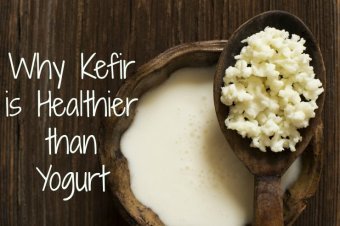
 I was chatting with a neighbor recently about her first attempt at culturing a quart of yogurt on the counter at room temperature, which unlike kefir, another type of fermented milk product, can sometimes be a little tricky to pull off.
I was chatting with a neighbor recently about her first attempt at culturing a quart of yogurt on the counter at room temperature, which unlike kefir, another type of fermented milk product, can sometimes be a little tricky to pull off.
The end result was soupy, and the culture didn’t seem to “take” unlike the heated yogurt she produced with her yogurt maker.
I explained that it usually takes several attempts at culturing yogurt at room temperature to determine the ideal scenario for a given home kitchen environment. Kefir, on the other hand, works nearly every single time like clockwork with a failure rate of basically zero no matter the temperature of the kitchen or the season of the year.
I encouraged her to give kefir a try instead of yogurt because ultimately, kefir is the healthier fermented milk product anyway (not to mention easier), for a couple of reasons.
Kefir is Easier than Yogurt to Culture Raw
In order to achieve success at culturing either yogurt or kefir, it’s very important to use the right type of starter.
- Mesophilic
- Thermophilic
Thermophilic is the type of yogurt starter ideal for a yogurt maker. It is heat-loving and cultures at around 110 F/43 C for 5 to 12 hours. The yogurt produced from thermophilic cultures is thicker than yogurt from a mesophilic culture.
A mesophilic yogurt starter, on the other hand, can be cultured at room temperature, around 70 – 77F/21 – 25C. When using a mesophilic culture, there is no need to preheat the milk. The culture is added to cold milk right out of the refrigerator and cultured at room temperature for 12-18 hours. The yogurt that results from culturing with a mesophilic starter is more drinkable style than the thicker, spoonable yogurt made from a thermophilic culture.
Unlike yogurt starter, kefir is solely a mesophilic culture, means that it is ideally cultured at room temperature.
Switching up the yogurt starter which has worked flawlessly with the yogurt maker and then using it to attempt raw yogurt cultured on the counter simply does not work in the majority of situations and a big reason why culturing raw yogurt fails so often for newbies to the home fermentation process.
Ensuring that you have the right type of yogurt starter for the purpose you have in mind, either raw or heated yogurt, can make all the difference to success. With the pricey cost of a gallon of raw, pastured milk in many areas of the world, minimizing mistakes is very important to the food budget as well.
If you have little room in the budget for mistakes and want to opt for the easiest raw fermented milk product to make, kefir is the way to go in my experience.
Yogurt Only Contains a Few Transient Based Probiotics
While ease of fermentation is a big plus for kefir, the biggest reason of all to ferment kefir instead of yogurt is due to the differences in the bacterial cultures each contain.
Yogurt, for example, only contains 2-7 strains of beneficial bacteria, called probiotics. Yogurt also contains no beneficial yeasts.
What? Beneficial yeasts?
Yes, there is such a thing as yeasts that are helpful to health … they help keep pathogenic yeasts in the gut like Candida at bay.
A traditional yogurt starter contains the following strains of probiotics: Bifidobacterium lactis, Lactobacillus acidophilus, Lactobacillus bulgaricus, and Streptococcus thermophilus.
Greek yogurt, which has taken the healthfood community by storm, is ironically the least beneficial of all, usually containing only Lactobacillus bulgaricus and Streptococcus thermophilus.
There is another shortcoming of the beneficial bacteria in yogurt: they are transitory in nature meaning they don’t colonize the digestive tract. Don’t get me wrong, yogurt based probiotics are valuable in that they help keep the digestive tract clean and provide food for the beneficial bacteria that are already colonized in the gut.
The probiotic strains in yogurt, however, do not colonize the gut themselves, and just pass through which requires a constant infusion to maintain the same health benefit.
A word of warning concerning yogurt and Greek yogurt containing Streptococcus thermophilus from Jordin Rubin, author of Restoring Your Digestive Health:
Studies have shown that people who suffer from autoimmune diseases run the risk of aggravating the symptoms of their disease if they consume more than two cups of yogurt that contains Streptococcus thermophilus. What’s more, Streptococcus thermophilus can cause a shift in immune function known as a Th2-dominated immune system. People with Th2-mediated immune systems have higher incidences of allergies and other illnesses. People suffering from digestive problems usually have imbalanced or weak immune systems. For this reason, avoiding products that may contribute to immune system dysfunction is wise if you have an intestinal disease.
So if you are seeking the best fermented milk product for gut health, it’s probably not yogurt particularly not in excess of two cups per day if the yogurt starter contains the strain Streptococcus thermophilus.
Beneficial Microbes in Kefir Blow Yogurt Away by a Country Mile
Milk kefir is quite different from yogurt in that the strains contained colonize the intestinal tract and don’t just pass through with temporary benefit. Some of the strains in kefir are aggressive in nature too, which means they attack and destroy pathogens reasserting dominance and control of the intestinal environment.
YOU MIGHT ALSO LIKE












